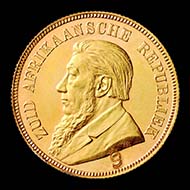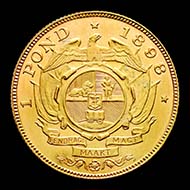June 24th, 2010 – The sale of South Africa’s rarest and most celebrated coin, the 1898 Single 9 Pond, has been concluded for an unprecedented multi-million rand figure. The sale, like the prior two sales of the same coin, was facilitated by Mr. Walter Fivaz. The buyer, who wishes to remain anonymous, is thrilled to own such an impressive and important part of South Africa’s heritage. The Single 9 has justifiably been dubbed the “King of South African Coins” and is among the most valuable rare coins in the world.
Upon completion of the purchase, the coin was promptly sent to NGC for certification. NGC was selected for its consistent grading, extensive South African numismatic knowledge and the prestige of its certification. The coin graded MS 63 PL by NGC. The grade of MS 63 identifies it as a choice uncirculated example. Many coins of such illustrious provenance have been mishandled, and fortunately this coin has retained its original surface quality. Additionally, the fields of the coin are mirror-like, indicating that it was struck from freshly polished dies. Accordingly, it has been designated PL, for proof-like, which is assigned to coins that possess some of the special attributes often seen on presentation coinage.
“We are very proud to certify such an important and historic coin. Seldom does a coin play so significant a role in cultural history, and for many years this coin has been considered the most coveted of all coins struck on the African continent,” commented Ken Krah, NGC vice president, who heads NGC’s World coin grading department.
The details surrounding the creation of the Single 9 Pond form one of the most compelling stories in numismatics. The Single 9 was the first one-pound gold coin produced during the Anglo-Boer War between South Africa and the British Empire in 1899. At that time, the government of the South African Republic sought legitimacy in the eyes of the international community. One of the best ways to do this was to manufacture their own coins and currency. Since they did not have a facility to produce dies for coinage in South Africa, the government contracted with a mint in Germany to create dies for 1899 coinage. En route from Germany to the Transvaal, the shipment of dies was intercepted and seized by the British.
Still wanting to press forward on making their own coins, the government’s solution was to use dies from 1898 and punch a 9 on the obverse of the 1898-dated coins. Once the first coin was made, they realized that the 9 was too large — it intruded on the bust of President Kruger. Only this first single coin was made with this punch, and all subsequent coins struck on this occasion were stamped with a pair of smaller nines. This second striking of coins is called the double 99 overstamp, and also comprises a rare and valuable South African coin; the single 9 stamp is unique.
The first coin, the Single 9, was immediately given to the United States Consul General, C. E. Macrum, as a means of confirming the South African Republic as an independent country with its own currency. Two pieces of correspondence concerning this event, one written by the government assayer at the time, J. Perrin, and the other by Macrum himself, still accompany the coin today. Macrum also had a small letter “M” engraved onto the coin, on the truncation of Kruger’s bust, as a permanent marker of its provenance.
NGC’s attribution for this coin includes the notation “‘M’ Monogram.” Although the coin was marked post-striking by its first owner, the monogram was not factored into the grade assigned. “This is standard practice when grading coins with historically important post-minting marks,” explained Krah. “Marks such as these actually help pedigree a coin. We believe that the Macrum mark on the base of the bust on the single 9 pond clearly falls into this historically significant category.”
The full pedigree of the coin is glamorous and very interesting. After Macrum took possession of the coin it is hard to trace, until the auction of the “Palace Collections of Egypt” in 1954, the collection assembled by King Farouk of Egypt. In the catalog it is noted that he procured the coin in Paris some years before. The coin was auctioned off with 18 other South African coins from the King’s enormous collection. Baldwin’s of London bought it on behalf of Dr. Froelich from Port Elizabeth, South Africa, for a sum of 655 Egyptian pounds.
The coin then remained in South Africa. The next time the coin appeared in public sale was in the Days Postal Auction No. 9 in 1969, where it sold for R2,530. In 1983 it came up for auction again through the Phoenix Postal Auction No. 30. Then it sold for R132,000. In 1999, the centenary year of the Anglo-Boer War, the coin was sold privately by dealer Walter Fivaz on behalf of Mr. Kraay for R4.65 million. Shortly thereafter, in 2001, it was again sold privately for R9.8 million. This current sales price, although undisclosed, reportedly places this coin squarely on the roster of highest-value rare coin transactions





